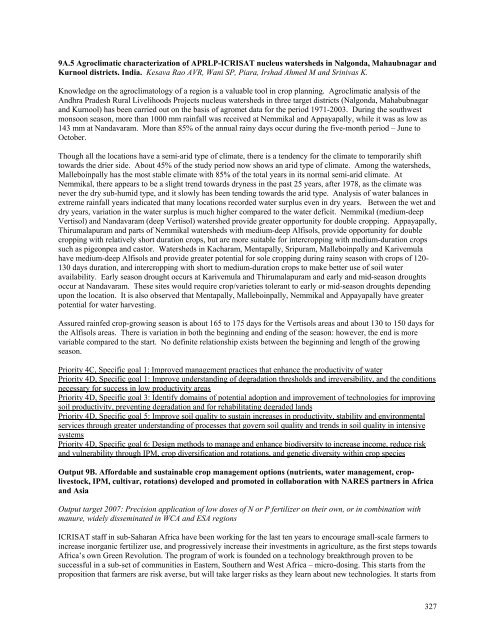ICRISAT Archival Report 2006 - The seedlings of success in the ...
ICRISAT Archival Report 2006 - The seedlings of success in the ...
ICRISAT Archival Report 2006 - The seedlings of success in the ...
You also want an ePaper? Increase the reach of your titles
YUMPU automatically turns print PDFs into web optimized ePapers that Google loves.
9A.5 Agroclimatic characterization <strong>of</strong> APRLP-<strong>ICRISAT</strong> nucleus watersheds <strong>in</strong> Nalgonda, Mahaubnagar and<br />
Kurnool districts. India. Kesava Rao AVR, Wani SP, Piara, Irshad Ahmed M and Sr<strong>in</strong>ivas K.<br />
Knowledge on <strong>the</strong> agroclimatology <strong>of</strong> a region is a valuable tool <strong>in</strong> crop plann<strong>in</strong>g. Agroclimatic analysis <strong>of</strong> <strong>the</strong><br />
Andhra Pradesh Rural Livelihoods Projects nucleus watersheds <strong>in</strong> three target districts (Nalgonda, Mahabubnagar<br />
and Kurnool) has been carried out on <strong>the</strong> basis <strong>of</strong> agromet data for <strong>the</strong> period 1971-2003. Dur<strong>in</strong>g <strong>the</strong> southwest<br />
monsoon season, more than 1000 mm ra<strong>in</strong>fall was received at Nemmikal and Appayapally, while it was as low as<br />
143 mm at Nandavaram. More than 85% <strong>of</strong> <strong>the</strong> annual ra<strong>in</strong>y days occur dur<strong>in</strong>g <strong>the</strong> five-month period – June to<br />
October.<br />
Though all <strong>the</strong> locations have a semi-arid type <strong>of</strong> climate, <strong>the</strong>re is a tendency for <strong>the</strong> climate to temporarily shift<br />
towards <strong>the</strong> drier side. About 45% <strong>of</strong> <strong>the</strong> study period now shows an arid type <strong>of</strong> climate. Among <strong>the</strong> watersheds,<br />
Mallebo<strong>in</strong>pally has <strong>the</strong> most stable climate with 85% <strong>of</strong> <strong>the</strong> total years <strong>in</strong> its normal semi-arid climate. At<br />
Nemmikal, <strong>the</strong>re appears to be a slight trend towards dryness <strong>in</strong> <strong>the</strong> past 25 years, after 1978, as <strong>the</strong> climate was<br />
never <strong>the</strong> dry sub-humid type, and it slowly has been tend<strong>in</strong>g towards <strong>the</strong> arid type. Analysis <strong>of</strong> water balances <strong>in</strong><br />
extreme ra<strong>in</strong>fall years <strong>in</strong>dicated that many locations recorded water surplus even <strong>in</strong> dry years. Between <strong>the</strong> wet and<br />
dry years, variation <strong>in</strong> <strong>the</strong> water surplus is much higher compared to <strong>the</strong> water deficit. Nemmikal (medium-deep<br />
Vertisol) and Nandavaram (deep Vertisol) watershed provide greater opportunity for double cropp<strong>in</strong>g. Appayapally,<br />
Thirumalapuram and parts <strong>of</strong> Nemmikal watersheds with medium-deep Alfisols, provide opportunity for double<br />
cropp<strong>in</strong>g with relatively short duration crops, but are more suitable for <strong>in</strong>tercropp<strong>in</strong>g with medium-duration crops<br />
such as pigeonpea and castor. Watersheds <strong>in</strong> Kacharam, Mentapally, Sripuram, Mallebo<strong>in</strong>pally and Karivemula<br />
have medium-deep Alfisols and provide greater potential for sole cropp<strong>in</strong>g dur<strong>in</strong>g ra<strong>in</strong>y season with crops <strong>of</strong> 120-<br />
130 days duration, and <strong>in</strong>tercropp<strong>in</strong>g with short to medium-duration crops to make better use <strong>of</strong> soil water<br />
availability. Early season drought occurs at Karivemula and Thirumalapuram and early and mid-season droughts<br />
occur at Nandavaram. <strong>The</strong>se sites would require crop/varieties tolerant to early or mid-season droughts depend<strong>in</strong>g<br />
upon <strong>the</strong> location. It is also observed that Mentapally, Mallebo<strong>in</strong>pally, Nemmikal and Appayapally have greater<br />
potential for water harvest<strong>in</strong>g.<br />
Assured ra<strong>in</strong>fed crop-grow<strong>in</strong>g season is about 165 to 175 days for <strong>the</strong> Vertisols areas and about 130 to 150 days for<br />
<strong>the</strong> Alfisols areas. <strong>The</strong>re is variation <strong>in</strong> both <strong>the</strong> beg<strong>in</strong>n<strong>in</strong>g and end<strong>in</strong>g <strong>of</strong> <strong>the</strong> season: however, <strong>the</strong> end is more<br />
variable compared to <strong>the</strong> start. No def<strong>in</strong>ite relationship exists between <strong>the</strong> beg<strong>in</strong>n<strong>in</strong>g and length <strong>of</strong> <strong>the</strong> grow<strong>in</strong>g<br />
season.<br />
Priority 4C, Specific goal 1: Improved management practices that enhance <strong>the</strong> productivity <strong>of</strong> water<br />
Priority 4D, Specific goal 1: Improve understand<strong>in</strong>g <strong>of</strong> degradation thresholds and irreversibility, and <strong>the</strong> conditions<br />
necessary for <strong>success</strong> <strong>in</strong> low productivity areas<br />
Priority 4D, Specific goal 3: Identify doma<strong>in</strong>s <strong>of</strong> potential adoption and improvement <strong>of</strong> technologies for improv<strong>in</strong>g<br />
soil productivity, prevent<strong>in</strong>g degradation and for rehabilitat<strong>in</strong>g degraded lands<br />
Priority 4D, Specific goal 5: Improve soil quality to susta<strong>in</strong> <strong>in</strong>creases <strong>in</strong> productivity, stability and environmental<br />
services through greater understand<strong>in</strong>g <strong>of</strong> processes that govern soil quality and trends <strong>in</strong> soil quality <strong>in</strong> <strong>in</strong>tensive<br />
systems<br />
Priority 4D, Specific goal 6: Design methods to manage and enhance biodiversity to <strong>in</strong>crease <strong>in</strong>come, reduce risk<br />
and vulnerability through IPM, crop diversification and rotations, and genetic diversity with<strong>in</strong> crop species<br />
Output 9B. Affordable and susta<strong>in</strong>able crop management options (nutrients, water management, croplivestock,<br />
IPM, cultivar, rotations) developed and promoted <strong>in</strong> collaboration with NARES partners <strong>in</strong> Africa<br />
and Asia<br />
Output target 2007: Precision application <strong>of</strong> low doses <strong>of</strong> N or P fertilizer on <strong>the</strong>ir own, or <strong>in</strong> comb<strong>in</strong>ation with<br />
manure, widely dissem<strong>in</strong>ated <strong>in</strong> WCA and ESA regions<br />
<strong>ICRISAT</strong> staff <strong>in</strong> sub-Saharan Africa have been work<strong>in</strong>g for <strong>the</strong> last ten years to encourage small-scale farmers to<br />
<strong>in</strong>crease <strong>in</strong>organic fertilizer use, and progressively <strong>in</strong>crease <strong>the</strong>ir <strong>in</strong>vestments <strong>in</strong> agriculture, as <strong>the</strong> first steps towards<br />
Africa’s own Green Revolution. <strong>The</strong> program <strong>of</strong> work is founded on a technology breakthrough proven to be<br />
<strong>success</strong>ful <strong>in</strong> a sub-set <strong>of</strong> communities <strong>in</strong> Eastern, Sou<strong>the</strong>rn and West Africa – micro-dos<strong>in</strong>g. This starts from <strong>the</strong><br />
proposition that farmers are risk averse, but will take larger risks as <strong>the</strong>y learn about new technologies. It starts from<br />
327

















